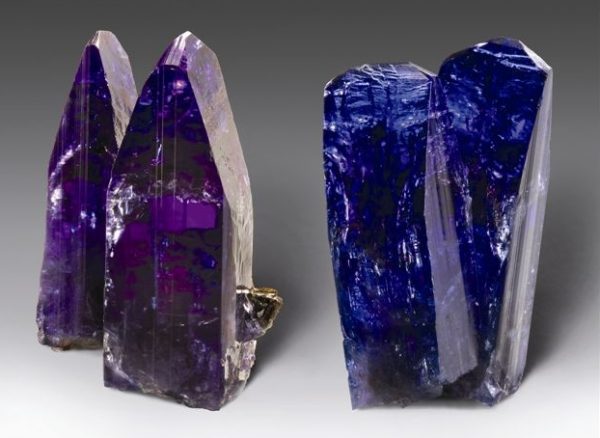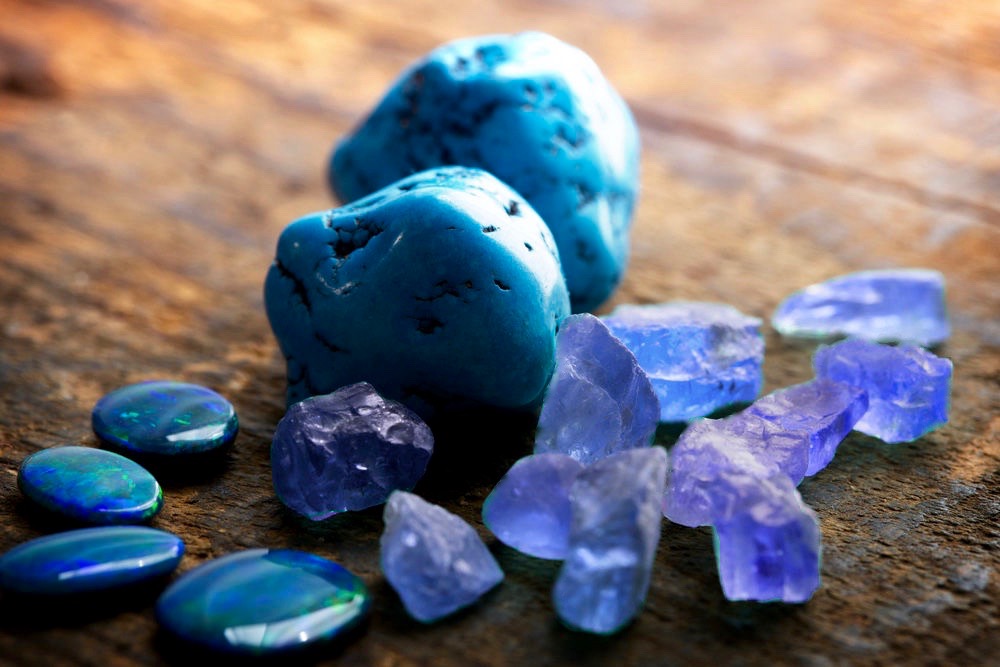Both beautiful December birthstones (lucky December babies!) turquoise and tanzanite both make a particularly fitting gift for someone in this birthday month. Although sharing the same time of year, they’re both unique and very different stones. Read on to discover the backgrounds of the two and how they compare.
Turquoise – what is it?
Turquoise is a precious stone first dating back to 6000 B.C., during the time of the Egyptians. It is one of the first and oldest gemstones that people have mined and used in jewellery.
The special blue-green hue of the stone is synonymous with the turquoise stone, known as ‘turquoise blue’. But the name turquoise in fact means ‘Turkish stone’, as the stone passed through Turkey, en route to Europe.
Some ancient cultures considered it a symbol of wealth and native Americans believed it was a sacred stone.

Turquoise meaning
In birthstone mythology, the turquoise stone is known for its healing and protective powers. Because ancient peoples believed it was a stone of safety and strength, it proved a popular material used in shields for warriors heading out to battle.
It has also been used in jewellery for royalty. For instance, in amulets for the likes of Cleopatra and King Tutankhamun, as a form of protection and good luck.


Where does turquoise originate from?
Much of today’s turquoise comes from Mexico and the USA, but the stone was originally imported from Iran.
Turquoise advantages and disadvantanges
Turquoise is a vibrant, beautiful stone that some consider to have protective and good luck powers. Astrologists claim it could be useful for healing, being beneficial for the whole body, but especially the bones.
Boasting a striking opaque colour like no other, the stone is famous for its ability to draw the eye and for being pleasantly smooth to touch. A splash of brightness against any outfit, turquoise is the perfect stone for someone who loves statement jewellery pieces.

Rating 5 – 6 on the Mohs scale of mineral hardness, turquoise is a fairly ‘soft’ stone. Therefore it is not generally recommended for everyday wear – for instance, jewellers consider it unsuitable for engagement rings.
Turquoise is the ideal stone to add a pop of colour to your outfits, or worn as statement jewellery on special occasions.
While it can be worn in the evening, its opaque surface and bright colour really jump out during the day and are ideal for accessorising casual daytime, as well as formal professional outfits.
Tanzanite – what is it?
Tanzanite is a precious stone, which was accidentally found by a gem prospector searching for diamonds in Tanzania in 1976. Because of this late discovery, we regard it as a relatively ‘new gem’ compared to other gemstones.
Even though tanzanite formed under the earth’s crust millions of years ago, it doesn’t have as much history of human use as some other gems – for example turquoise, which has a much older heritage.

Tanzanite showcases a shimmering blue-violet colour. Thanks to an effect called ‘trichroism’, it appears to sparkle in different blue and violet hues depending on the angle you look at it from. This makes it particularly mesmerising to look at.
Quickly gaining a following despite not having been around as long as other gems, celebrities including Cate Blanchett, Katy Perry and Anne Hathaway have all been seen wearing tanzanite jewellery on red carpets in recent years.
Tanzanite meaning
The name ‘tanzanite’ comes from Tanzania where the stone first originated from and was first discovered.
Some say the stone is useful in treating stress as well as enhancing vitality and helping to make the immune system stronger.
Tanzanian Maasai tribes are known to use tanzanite crystals as amulets. They consider tanzanite to be particularly beneficial to expectant mothers, awarding health, fertility and protection.


Where does the stone originate from?
The stone can only be found in Tanzania, in the foothills of Mount Kilimanjaro. Up until today, no one has been able to find any further deposits of tanzanite anywhere else in the world. This makes tanzanite rarer than diamonds.
An extremely valuable stone, the Tanzanian government are very strict on its mining and selling. It is particularly profitable and beneficial to the country’s economy.


Tanzanite advantages and disadvantages
A gorgeous gemstone, tanzanite is a beautiful gift for anyone who loves colour and is looking for a modern, luxurious, sparkling gemstone. Its incredible trichroism means it is famous for showing a variety of different colours, from blue to violet and even burgundy.
Items like tanzanite stud earrings make elegant yet discreet accessories, and larger tanzanite gems create stunning statement pieces. Tanzanite can be used to add a touch of luxury to any outfit, including daytime and professional wear, but really comes to its in own in the evening, lending sparkle and glamour.
At a 6.5 to 7 in mineral hardness on the Mohs scale, tanzanite gems are fairly hardy but if subjected to a forceful knock, they could become brittle. Looked after with lots of care, they can be worn everyday. Although tanzanite perhaps wouldn’t be the first recommendation jewellers give for items requiring daily wear like engagement rings.

The low down – tanzanite or turquoise?
Tanzanite and turquoise are both incredibly beautiful gemstones, and they make a stunning gift for yourself or a loved one celebrating a December birthday. Ultimately, which one you wear is down to personal preference – and if you cannot choose then you can also wear both.
If you have to choose, then turquoise would be more suited to someone looking for a classic, vintage-feel gemstone that provides striking colour and feel pleasing against the skin. Tanzanite would be suited to someone looking for a contemporary and luxurious-looking gem with stunning shimmering colour and plenty of sparkle.
READ NEXT – Tanzanite December Birthstone Meaning
Liked this? Why not follow us on Facebook or Instagram?
Shop beautiful gemstone jewellery at TheDiamondStore.co.uk.




Both beautiful December birthstones (lucky December babies!) turquoise and tanzanite both make a particularly fitting gift for someone in this birthday month. Although sharing the same time of year, they’re both unique and very different stones. Read on to discover the backgrounds of the two and how they compare.
Turquoise – what is it?
Turquoise is a precious stone first dating back to 6000 B.C., during the time of the Egyptians. It is one of the first and oldest gemstones that people have mined and used in jewellery.
The special blue-green hue of the stone is synonymous with the turquoise stone, known as ‘turquoise blue’. But the name turquoise in fact means ‘Turkish stone’, as the stone passed through Turkey, en route to Europe.
Some ancient cultures considered it a symbol of wealth and native Americans believed it was a sacred stone.
Turquoise meaning
In birthstone mythology, the turquoise stone is known for its healing and protective powers. Because ancient peoples believed it was a stone of safety and strength, it proved a popular material used in shields for warriors heading out to battle.
It has also been used in jewellery for royalty. For instance, in amulets for the likes of Cleopatra and King Tutankhamun, as a form of protection and good luck.
Where does turquoise originate from?
Much of today’s turquoise comes from Mexico and the USA, but the stone was originally imported from Iran.
Turquoise advantages and disadvantanges
Turquoise is a vibrant, beautiful stone that some consider to have protective and good luck powers. Astrologists claim it could be useful for healing, being beneficial for the whole body, but especially the bones.
Boasting a striking opaque colour like no other, the stone is famous for its ability to draw the eye and for being pleasantly smooth to touch. A splash of brightness against any outfit, turquoise is the perfect stone for someone who loves statement jewellery pieces.
Rating 5 – 6 on the Mohs scale of mineral hardness, turquoise is a fairly ‘soft’ stone. Therefore it is not generally recommended for everyday wear – for instance, jewellers consider it unsuitable for engagement rings.
Turquoise is the ideal stone to add a pop of colour to your outfits, or worn as statement jewellery on special occasions.
While it can be worn in the evening, its opaque surface and bright colour really jump out during the day and are ideal for accessorising casual daytime, as well as formal professional outfits.
Tanzanite – what is it?
Tanzanite is a precious stone, which was accidentally found by a gem prospector searching for diamonds in Tanzania in 1976. Because of this late discovery, we regard it as a relatively ‘new gem’ compared to other gemstones.
Even though tanzanite formed under the earth’s crust millions of years ago, it doesn’t have as much history of human use as some other gems – for example turquoise, which has a much older heritage.
Tanzanite showcases a shimmering blue-violet colour. Thanks to an effect called ‘trichroism’, it appears to sparkle in different blue and violet hues depending on the angle you look at it from. This makes it particularly mesmerising to look at.
Quickly gaining a following despite not having been around as long as other gems, celebrities including Cate Blanchett, Katy Perry and Anne Hathaway have all been seen wearing tanzanite jewellery on red carpets in recent years.
Tanzanite meaning
The name ‘tanzanite’ comes from Tanzania where the stone first originated from and was first discovered.
Some say the stone is useful in treating stress as well as enhancing vitality and helping to make the immune system stronger.
Tanzanian Maasai tribes are known to use tanzanite crystals as amulets. They consider tanzanite to be particularly beneficial to expectant mothers, awarding health, fertility and protection.
Where does the stone originate from?
The stone can only be found in Tanzania, in the foothills of Mount Kilimanjaro. Up until today, no one has been able to find any further deposits of tanzanite anywhere else in the world. This makes tanzanite rarer than diamonds.
An extremely valuable stone, the Tanzanian government are very strict on its mining and selling. It is particularly profitable and beneficial to the country’s economy.
Tanzanite advantages and disadvantages
A gorgeous gemstone, tanzanite is a beautiful gift for anyone who loves colour and is looking for a modern, luxurious, sparkling gemstone. Its incredible trichroism means it is famous for showing a variety of different colours, from blue to violet and even burgundy.
Items like tanzanite stud earrings make elegant yet discreet accessories, and larger tanzanite gems create stunning statement pieces. Tanzanite can be used to add a touch of luxury to any outfit, including daytime and professional wear, but really comes to its in own in the evening, lending sparkle and glamour.
At a 6.5 to 7 in mineral hardness on the Mohs scale, tanzanite gems are fairly hardy but if subjected to a forceful knock, they could become brittle. Looked after with lots of care, they can be worn everyday. Although tanzanite perhaps wouldn’t be the first recommendation jewellers give for items requiring daily wear like engagement rings.
The low down – tanzanite or turquoise?
Tanzanite and turquoise are both incredibly beautiful gemstones, and they make a stunning gift for yourself or a loved one celebrating a December birthday. Ultimately, which one you wear is down to personal preference – and if you cannot choose then you can also wear both.
If you have to choose, then turquoise would be more suited to someone looking for a classic, vintage-feel gemstone that provides striking colour and feel pleasing against the skin. Tanzanite would be suited to someone looking for a contemporary and luxurious-looking gem with stunning shimmering colour and plenty of sparkle.
READ NEXT – Tanzanite December Birthstone Meaning
Liked this? Why not follow us on Facebook or Instagram?
Shop beautiful gemstone jewellery at TheDiamondStore.co.uk.
Discover more
Share this: